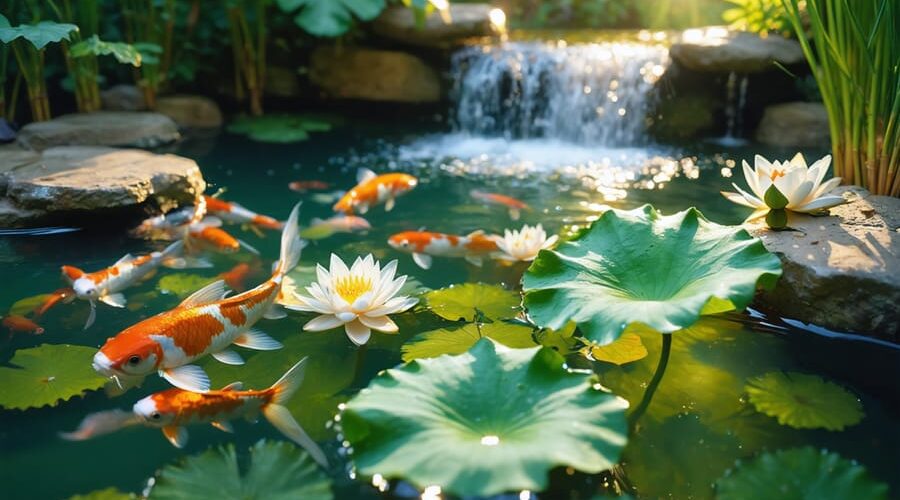
The Hidden Chemistry Making Your Pond Fish Sick (And How to Fix It)
Your pond looks crystal clear, your fish seem healthy, yet something feels *off*—maybe the koi aren’t as vibrant as they should be, or that stubborn algae bloom keeps returning no matter what you do. The culprit might be invisible to the naked eye: trace elements, those microscopic minerals present in such tiny amounts that standard test kits miss them completely, yet they’re absolutely critical to your pond’s ecosystem balance.
I learned this the hard way three years ago when my beloved water lilies stopped blooming despite perfect pH and ammonia levels. After months of frustration, a trace element test revealed severe iron deficiency—a problem I didn’t even know existed. Once corrected, those lilies exploded with flowers within weeks.
Trace elements include minerals like iron, manganese, copper, zinc, and boron—substances needed in concentrations measured in parts per million or even parts per billion. While your pond needs only microscopic amounts, too little causes deficiency symptoms (stunted plant growth, dull fish coloration, weakened immune systems), while too much becomes toxic. It’s a delicate balancing act that most pond owners never consider until problems arise.
Unlike major water parameters you’re probably familiar with—pH, ammonia, nitrites—trace elements operate behind the scenes as enzyme activators, metabolic catalysts, and structural components in living cells. They’re the supporting actors that make the entire production work smoothly. Understanding how to test for them, recognize deficiency or toxicity symptoms, and make targeted corrections transforms pond keeping from guesswork into precision care. Let’s demystify this often-overlooked aspect of water chemistry and give you the tools to diagnose and solve those mysterious pond problems once and for all.
What Are Trace Elements and Why Should Pond Owners Care?
Think of trace elements as the multivitamins for your pond—they’re needed in tiny amounts, but boy, do they pack a punch! Just like you need vitamin C and zinc to stay healthy, your pond water relies on these microscopic nutrients to keep everything thriving.
Here’s the thing: when I first started with my backyard pond, I obsessed over the big stuff—pH levels, ammonia, nitrates. Those are your “major nutrients,” the headliners of pond chemistry fundamentals. But I kept scratching my head wondering why my water lilies looked pale despite perfect nitrogen levels. Turns out, I was missing the supporting cast—the trace elements.
**What Makes Them Different?**
Major nutrients like nitrogen and phosphorus are needed in large quantities, kind of like how your body needs lots of protein and carbohydrates. Trace elements, on the other hand, are required in such minute amounts that they’re measured in parts per million or even parts per billion. But don’t let their tiny presence fool you—without them, your pond ecosystem can’t function properly.
**The Essential Five**
Let’s meet the trace element superstars your pond depends on:
**Iron** acts like the oxygen delivery truck for aquatic plants. Without enough iron, plants can’t produce chlorophyll, leaving them pale and weak—just like anemia in humans.
**Copper** functions as your pond’s immune system booster. It helps fish fight off parasites and supports enzyme function, though too much becomes toxic (balance is everything!).
**Zinc** works as the wound healer and growth promoter. Fish need it for healthy scales and tissue repair.
**Manganese** serves as the photosynthesis assistant for plants, helping them capture and use sunlight efficiently.
**Boron** plays the role of plant structure builder, strengthening cell walls and supporting healthy growth patterns.
These microscopic helpers work behind the scenes, and when even one goes missing or gets out of balance, your entire pond can show symptoms that leave you puzzled and frustrated.
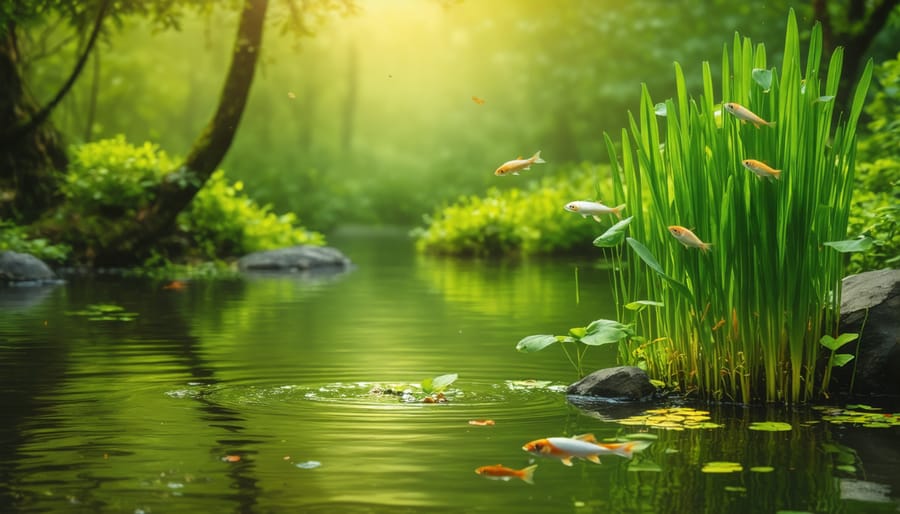
Signs Your Pond Water Chemistry Might Be Off
When Your Fish Are Telling You Something’s Wrong
Your fish are often the first to sound the alarm when something’s off in your pond’s trace element balance. I learned this the hard way when my once-vibrant koi started acting sluggish and hiding behind plants—something was clearly wrong, but my basic test kit showed “normal” readings.
Watch for these telltale signs: Fish gasping at the surface despite good oxygen levels might indicate copper toxicity. Faded colors or a “washed out” appearance often point to iron or manganese deficiencies. Fins that appear ragged or won’t heal, even without obvious infection, could signal zinc problems. If your fish seem lethargic, hanging at the bottom or showing little interest in food, trace element imbalances might be the culprit.
The tricky part? These symptoms can overlap with other issues, which is why trace element testing becomes so valuable. When standard water parameters check out fine but your fish still aren’t thriving, it’s time to dig deeper into those micro-nutrients lurking beneath the surface.
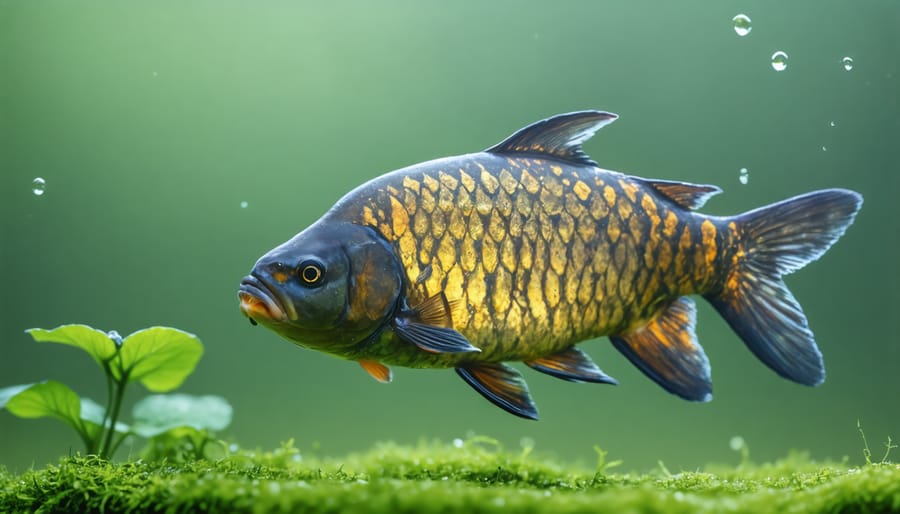
Plant Problems That Point to Chemical Imbalances
Your aquatic plants are incredible communicators—they’ll tell you exactly when something’s off with your water chemistry! The trick is learning to read their signals.
**Yellowing leaves** (especially on new growth) often point to iron deficiency. I’ve seen beautiful water lilies turn pale yellow-green when iron levels drop, looking washed out instead of vibrant. Sometimes you’ll notice the veins stay green while the leaf tissue between them turns yellow—that’s a classic iron shortage calling card.
**Stunted or distorted growth** suggests manganese or zinc problems. Your plants might produce smaller leaves than normal, or new shoots seem weak and struggle to unfurl properly. I once watched a gorgeous iris barely reach half its usual height because of trace element depletion after a water change.
**Poor flowering** frequently indicates boron deficiency. When plants produce plenty of leaves but flowers are sparse, small, or fail to develop fully, it’s time to investigate your trace elements.
**Brown spots or holes** in leaves can signal calcium or magnesium issues, though these technically aren’t trace elements—they’re still worth checking.
The good news? Once you spot these symptoms, targeted trace element testing can pinpoint exactly what’s missing!
Water Quality Clues You Can See
Your pond often tells you when something’s wrong with its trace element balance—you just need to know what to look for! I remember staring at my pond one summer, frustrated by the pea-green water that wouldn’t clear no matter what I tried. Turns out, my trace elements were completely out of whack.
Here are the visual clues that suggest you might have trace element issues:
**Persistent algae blooms** that keep returning despite your best natural algae control efforts often indicate excess phosphorus or iron in the water.
**Cloudy or murky water** that stays hazy even after filtration can signal imbalances in calcium, magnesium, or manganese levels affecting water clarity.
**Unusual water colors**—like a rust-orange tint (excess iron), milky white appearance (calcium carbonate precipitation), or greenish-brown hues—are telltale signs something’s off chemically.
**Stunted or yellowing plants** with poor growth patterns frequently point to trace element deficiencies, particularly iron, which plants need for photosynthesis.
While these visual cues won’t tell you exactly which trace elements are problematic, they’re your pond’s way of waving a red flag that it’s time to dig deeper with proper testing.
How to Test Your Pond’s Trace Elements (The Simple Way)
DIY Testing Kits: What They Can and Can’t Tell You
Here’s the reality: most affordable pond test kits don’t directly measure trace elements like iron, manganese, or boron. What they *do* measure brilliantly are the major players—pH, ammonia, nitrite, nitrate, and sometimes hardness. These give you crucial baseline information about your pond’s overall health, and honestly, that’s where most problems start anyway.
I learned this the hard way when my water lilies looked pale and sickly. I bought an inexpensive kit expecting it to reveal some exotic deficiency, but it actually showed my pH was way off, which was preventing plants from accessing nutrients already present! Understanding water testing basics saved me from chasing ghosts.
Most DIY kits use simple color-matching strips or liquid reagents. They’re perfect for regular monitoring and cost between $15-40. Follow the instructions precisely—timing matters! Wait the full recommended period before reading results, and test in good lighting.
**What they CAN tell you:** General water quality, whether conditions support healthy fish and plants, if major imbalances exist.
**What they CAN’T tell you:** Specific trace element concentrations, subtle micronutrient deficiencies, or precise measurements of elements like copper or zinc.
For true trace element analysis, you’ll need laboratory testing (usually $50-150) where you send water samples to specialists. But start with basic testing first—it solves 80% of pond problems and helps you understand whether deeper investigation is actually necessary.
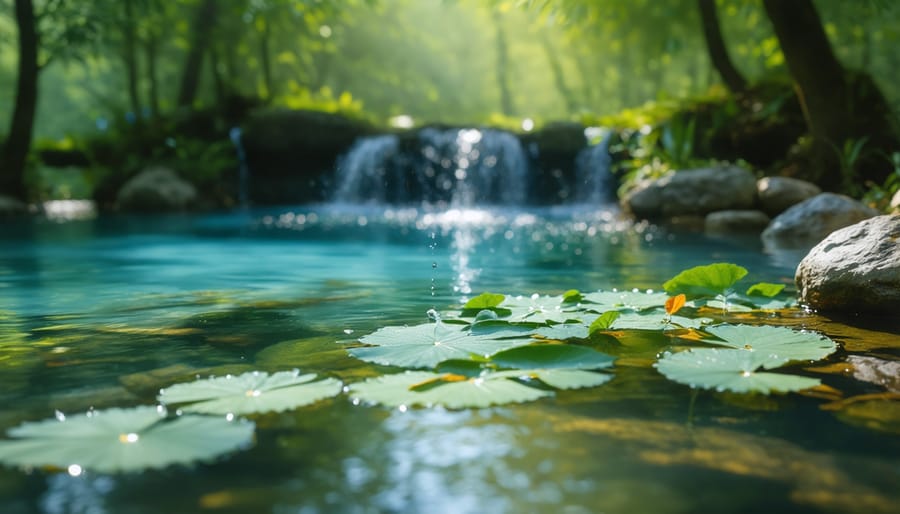
When to Send Your Water to a Lab
Sometimes your home test kits just aren’t giving you the full picture, especially when you’re dealing with persistent problems that don’t make sense. That’s when it’s time to call in the professionals and send a water sample to a certified lab.
A comprehensive lab analysis typically covers everything from basic parameters like pH and ammonia to a full spectrum of trace elements—iron, copper, zinc, manganese, boron, and even heavy metals you can’t test for at home. Think of it as a complete health checkup for your pond. I sent my first sample after three months of unexplained plant yellowing, and discovering a severe manganese deficiency finally gave me answers my basic test strips couldn’t provide.
Most labs provide detailed reports with actual concentration levels and recommendations, which is invaluable for troubleshooting. You’ll know exactly what you’re working with rather than guessing from color charts.
Collecting samples properly is crucial—use clean containers (labs often provide them), rinse thoroughly with pond water first, fill to the recommended level, and ship immediately or refrigerate if there’s a delay. Never use soap or household containers, as residues will contaminate results.
Cost-wise, expect to pay between $30 for basic screening to $100 for comprehensive trace element panels. It’s an investment, but compared to repeatedly treating symptoms without understanding the cause, it’s money well spent. Most pond supply companies and agricultural extension offices can recommend reputable water testing laboratories near you.
Reading Your Test Results Without a Science Degree
Good news—you don’t need a chemistry background to understand your test results! Most trace element tests provide measurements in parts per million (ppm) or micrograms per liter (µg/L), which are the same thing.
Here’s what healthy pond water typically looks like:
**Iron:** 0.01-0.3 ppm (plants need it; too much causes algae blooms)
**Copper:** Below 0.02 ppm (higher levels harm fish)
**Zinc:** 0.03-0.05 ppm (essential but toxic above 0.1 ppm)
**Manganese:** 0.01-0.2 ppm (supports plant growth)
**Boron:** 0.01-0.1 ppm (aids flowering aquatics)
Think of these ranges like Goldilocks—not too much, not too little, but just right! If your results fall outside these ranges, don’t panic. Small variations are normal, but consistent readings above or below signal it’s time to take action and rebalance your pond.
Fixing Trace Element Problems in Your Pond
Dealing With Too Little: Safe Ways to Add Trace Elements
Discovering your pond is low on trace elements doesn’t mean you need to panic—think of it like realizing your garden needs a bit of fertilizer. The golden rule here is patience. Adding too much too quickly can shock your fish and disrupt the balance you’ve worked hard to maintain.
**Pond-Safe Commercial Products**
Your local pond supply store offers trace element supplements specifically formulated for water gardens. Look for products that list exact ingredients and dosing instructions. I always recommend starting at half the suggested dose, then testing again after a week. It’s much easier to add more than to fix an overdose! Choose liquid supplements over powders when possible—they distribute more evenly throughout your pond.
**Natural Supplementation Methods**
Mother Nature provides some wonderful options too. Certain rocks naturally release trace elements into water. Lava rock and basalt are excellent choices that slowly leach beneficial minerals while providing surface area for beneficial bacteria. I’ve placed chunks of these around my pond’s edges, and they’ve worked beautifully over time.
Live aquatic plants are your secret weapon. Species like anacharis, hornwort, and water lettuce absorb nutrients from the water while releasing trace elements through their root systems. They’re essentially living supplements that also look gorgeous!
**The Slow-and-Steady Approach**
Remember, trace elements are needed in tiny amounts—that’s why they’re called “trace”! Test your water before adding anything, supplement conservatively, then retest after 7-10 days. Keep a simple log noting what you added and when. This patience protects your fish and prevents the frustrating cycle of overcorrecting problems. Your pond will thank you for taking it slow.
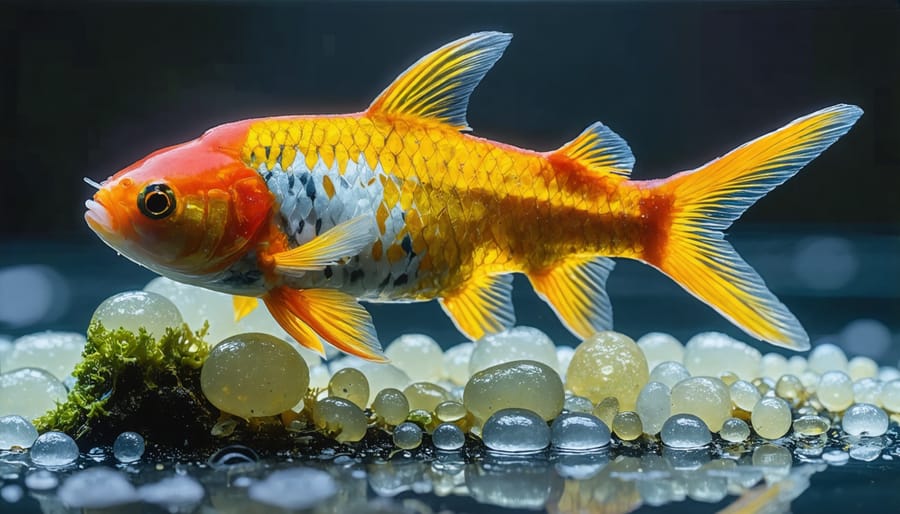
When You Have Too Much: Reducing Excess Trace Elements
If your test results show trace element levels are running too high, don’t panic—there are several safe and effective ways to bring things back into balance.
**Water Changes: Your First Line of Defense**
The simplest solution is often the best! Regular partial water changes dilute excess trace elements naturally. I typically recommend changing 10-20% of your pond water weekly when dealing with elevated levels. Just remember to dechlorinate any tap water before adding it to protect your fish.
**Activated Carbon to the Rescue**
Adding activated carbon to your filtration system works like a magnet for many dissolved metals and compounds. Replace it monthly for best results, as it loses effectiveness once saturated. Think of it as your pond’s detox treatment!
**Nature’s Cleanup Crew: Aquatic Plants**
Certain plants are remarkable at absorbing excess metals from water. Water hyacinths, duckweed, and watercress are particularly talented at this job. As they grow, they literally pull trace elements from the water and store them in their tissues. Just harvest and remove plants regularly to permanently export those elements from your pond ecosystem.
**Chelating Agents: Use With Caution**
Commercial chelating products can bind to excess metals, making them less harmful. However, approach these carefully—they’re powerful and can stress fish if misused. Always follow manufacturer instructions precisely and monitor your fish closely for signs of distress like gasping or unusual behavior during treatment.
The Natural Balance Approach
Here’s the thing about trace elements—nature’s already brilliant at managing them! A healthy pond ecosystem works like a well-oiled machine. Beneficial bacteria break down organic waste, converting harmful compounds into harmless ones. Your aquatic plants? They’re constantly absorbing trace elements through their roots and leaves, acting as natural filters. And those natural filtration systems you’ve installed are working around the clock to keep everything balanced.
The secret to maintaining this balance is consistency. Regular partial water changes (about 10-15% weekly) prevent trace elements from accumulating to problematic levels. Don’t overfeed your fish—uneaten food breaks down into compounds that throw off your chemistry. Keep your biofilter healthy by avoiding harsh chemicals that kill beneficial bacteria. Add plenty of aquatic plants; they’re your best allies in naturally regulating trace elements. Think of it as maintaining momentum rather than constantly fighting problems!
Common Trace Element Troublemakers in Backyard Ponds
Iron: Friend or Foe?
Iron has quite the split personality in your pond! On the helpful side, it’s absolutely essential for aquatic plants—they need it to produce that gorgeous green chlorophyll. I’ve seen water lilies perk right up after iron supplementation. But here’s where things get tricky: too much iron causes those unsightly rust-colored stains on your pond liner, rocks, and waterfall features. Worse yet, excess iron can fuel stubborn algae blooms that turn your water murky.
So when should you worry? If you’re seeing reddish-brown staining or unexplained algae despite good filtration, test your iron levels. Ideal iron concentrations sit below 0.3 ppm. Above that, you might need a filtration upgrade or chelated iron products that feed plants without causing problems. If your plants look pale but iron levels are fine, the issue might be pH preventing iron absorption—another reason comprehensive testing matters!
Copper: The Accidental Killer
Copper sneaks into your pond in surprising ways – old pennies tossed in for “good luck,” copper-based algaecides, or even the plumbing leading to your water feature. While tiny amounts can be harmless, copper becomes an accidental killer at higher concentrations.
Fish are particularly vulnerable. At levels above 0.3 parts per million (ppm), copper damages their gills, making breathing difficult. I learned this the hard way when my koi started gasping after I treated an algae bloom with copper sulfate. Even worse, copper decimates beneficial bacteria that keep your biological filter running smoothly.
Ironically, those helpful string algae-eating organisms you want? Copper wipes them out too.
Safe copper levels should stay below 0.2 ppm for most pond fish. If you’re using copper-based treatments, follow dosing instructions religiously and test frequently. Better yet, remove those decorative pennies – modern ones are mostly zinc anyway, which creates its own problems! When copper levels climb too high, partial water changes and activated carbon in your filter help remove excess copper before it harms your aquatic friends.
Zinc and Manganese: The Forgotten Essentials
While everyone focuses on nitrogen and phosphorus, zinc and manganese quietly work behind the scenes keeping your pond thriving. I learned this the hard way when my koi developed frayed fins and my water lilies stopped blooming—despite perfect pH and crystal-clear water!
Zinc acts as an immune system superhero for fish, helping them fight off infections and heal wounds. Without enough zinc, you’ll notice fish becoming sluggish, losing appetite, or developing cloudy eyes. For plants, zinc deficiency shows up as yellowing between leaf veins and stunted new growth.
Manganese partners with zinc to support plant photosynthesis and overall vigor. When manganese runs low, your pond plants develop pale, twisted leaves that look almost bleached. Your once-lush water garden suddenly seems lackluster, and you can’t figure out why.
These deficiencies often sneak up after heavy rains wash away trace elements or when you’ve been diligent about water changes without replenishing what you’ve removed. The good news? Once you identify the problem through testing, these elements are easily restored with targeted supplements.
Keeping Your Pond Chemistry Stable Year-Round
The best way to avoid trace element headaches? Don’t let problems develop in the first place! I’ve learned through years of pond keeping that a simple monthly check-in saves me from major dramas down the road. Trust me, spending 15 minutes each month beats dealing with a full-blown algae takeover or watching your fish struggle.
Your pond faces different challenges throughout the year, and understanding these seasonal shifts makes all the difference. In spring, that lovely runoff from melting snow and heavy rains can flood your pond with minerals from surrounding soil—sometimes helpful iron and manganese, other times problematic heavy metals. I always test trace elements after the first big spring thaw to see what Mother Nature has delivered.
Summer brings its own quirks. As water evaporates in the heat, trace elements become concentrated—what was balanced in May might be excessive by July. Top up regularly with dechlorinated water rather than letting levels drop too far, and test monthly during peak evaporation season. I’ve marked my calendar with reminders because it’s easy to forget when everything looks fine on the surface.
Fall is when I’m really vigilant. Those beautiful autumn leaves? They’re trace element time bombs. As they decompose, they release iron, manganese, and other elements that can throw your balance off. Netting your pond or skimming daily prevents this seasonal surge. I learned this the hard way after one October when I got lazy about leaf removal and spent November battling unexpected water quality issues.
Your seasonal maintenance routine should include a quick 15-minute monthly ritual: check water temperature, top up if needed, test your key trace elements (iron, copper, and one or two others relevant to your pond’s history), and record the results in a simple notebook. This log becomes invaluable—patterns emerge that help you anticipate problems.
Between tests, observe your pond daily. Are plants yellowing? Fish acting sluggish? Algae suddenly thriving? These visual cues often signal trace element imbalances before your test kit does. Prevention combined with observation keeps your pond chemistry stable year-round without becoming a second job.
Understanding trace elements doesn’t require a chemistry degree or complicated equipment—just a bit of awareness and attention to what your pond is telling you. I remember feeling overwhelmed when I first heard about iron, manganese, and boron, thinking I’d need a laboratory setup. But here’s the truth: basic testing kits and simple observations will take you surprisingly far. When you notice your water lilies producing fewer blooms or your fish acting lethargic, you now know to look beyond the usual suspects.
The beauty of trace element management is that small changes create significant results. Adding a chelated iron supplement or adjusting your fertilization routine aren’t expensive or time-consuming fixes—they’re gentle nudges that help your pond find its balance. This “hidden chemistry” might be invisible, but its effects are wonderfully visible in thriving plants, vibrant fish, and clear water that makes you proud.
Think of trace elements as the seasoning in your pond’s recipe. Too little, and everything tastes bland. The right amount? That’s when the magic happens. You’ve already invested time creating your outdoor oasis—understanding these microscopic helpers simply ensures you get the most enjoyment from your efforts.
So here’s your next step: grab a test kit this weekend and take a closer look at your water. Walk around your pond with fresh eyes, noticing those subtle signs you might have dismissed before. Document what you see, test what you can, and make one small adjustment. You’ll be amazed how quickly your pond responds when you speak its chemical language. Happy pond keeping!
